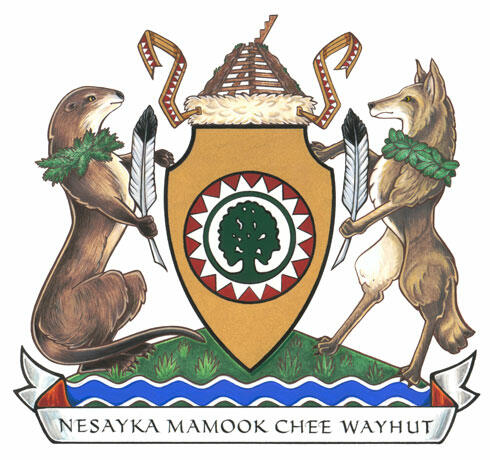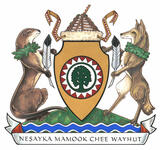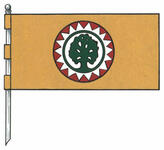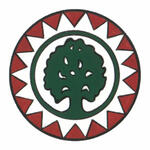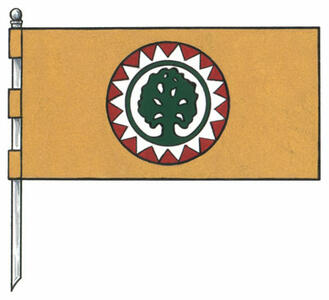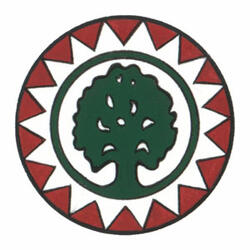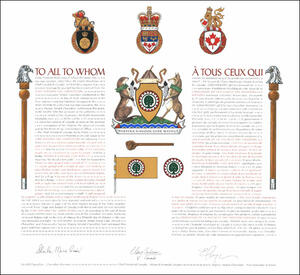The contents of this Register are intended for research purposes only. The heraldic emblems found in the Register may not be reproduced in any form or in any media without the written consent of the Canadian Heraldic Authority and/or the recipient.
Kamloops, British Columbia
Grant of Arms, Supporters, Flag, Badge, Commissioner’s Gavel and Commissioner’s Staff
October 15, 2008
Vol. V, First Peoples, p. 1
Arms of the First Nations Tax CommissionBlazonOr on a torteau a plate dancetty charged with a maple tree issuant from and encircled by an annulus Vert; SymbolismThe central emblem is that designed for the First Nations Tax Commission (FNTC)’s predecessor body, the Indian Taxation Advisory Board, by Tom Maracle of the Tyendinaga Mohawk Territory. The patterned outer circle represents the jurisdiction of First Nations’ governments. The tree, strong and enduring, is symbolic of life, a habitat of animals and birds, a provider of shelter, heat, medicine, clean air, and soil stability. Its branches and leaves represent First Nations communities and individuals within these communities. As it is a maple, it also represents Canada. The yellow is associated with chalcedony, the east, and illumination. Red is the colour of the north and of spiritual purity. Green is the colour associated with the earth. The arrowhead shape of the shield reminds us of the First Nations way of life, especially related to trade and sustenance, going back countless centuries. |
CrestBlazonA winter lodge of the Kamloops people set on a headband of coyote fur proper; SymbolismThe winter lodge appears on the coat of arms of the Kamloops Indian Band of the Shuswap Nation, and marks the fact that the FNTC has its head office on the site of this band, a leading First Nations community in the field of real estate development. More generally, as a form of shelter, the winter lodge speaks to the Commission’s role in allowing housing to benefit the community. The coyote fur, in the place of the traditional heraldic wreath, is based on the scouting hat and refers to the Commission’s work in looking ahead and providing for the future. |
MottoBlazonNESAYKA MAMOOK CHEE WAYHUT; SymbolismThe Chinook motto meaning “We build a new path” refers to the Commission’s role in assisting First Nations governments to develop by means of establishing appropriate systems of property taxation. Chinook, a 19th century trade language used extensively in western Canada and the United States, was spoken by many different First Nations as well as Europeans, Chinese and Hawaiians. It was therefore multicultural and represents communications among First Nations and between First Nations and other cultures. |
SupportersBlazonDexter an otter gorged with a wreath of fir, sinister a coyote gorged with a wreath of sage, each holding an eagle feather proper and standing on a grassy mount Vert set with a bar wavy Azure fimbriated Argent; SymbolismThe coyote was sent down by the Creator to teach humans how to develop a society. The otter has intimate knowledge of the worlds of both land and water. Just as the otter is able to move comfortably between two worlds, so too should all people be able to live in the present while at the same time honouring their past and traditions. The feather eagle is an important symbol of authority in First Nations culture. The mount of grass emphasizes the importance of land, and the representation of water refers to the role of water in trade and communications. |
Commissioner’s Staff of the First Nations Tax CommissionBlazonCommissioner’s Staff: A staff ensigned by a sphere, a cube proper and an eagle’s head erased Argent; SymbolismCommissioner’s Staff: This pays tribute to the staves given to chiefs by Governor Seymour and others, and represents the authority of First Nations governments. The sphere signifies the earth, and the square a plot of land. The eagle’s head repeats the symbolism of the eagle feathers. |
Additional InformationCreator(s)Original concept of Bruce Patterson, Saint-Laurent Herald, assisted by the heralds of the Canadian Heraldic Authority. PainterDebra MacGarvie CalligrapherShirley Mangione Recipient TypeCivil Institution |

